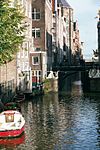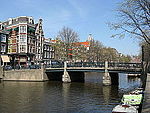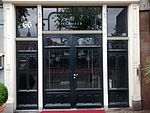Schreierstoren

The Schreierstoren (English incorrectly translated as: Weeper's Tower), originally part of the medieval city wall of Amsterdam, the Netherlands, was built in the 15th century. It was the location from which Henry Hudson set sail on his journey to Northern America. This expedition would lead to the discovery of the island of Manhattan among others. It was built as a defense tower in 1487. It is currently a café and nautical bookstore. The old name was 'Schreyhoeckstoren' meaning in old Dutch the sharp angle of the tower with the once connected citywalls. Later they started calling it in short the Schreierstoren. Schreierstoren is known mainly for the fact that women wept there for their husbands, who would leave from that port, to go to war, or to fish. (Most of the weeping that was done was for the fishermen who left from that port.) While many in history have called this (the weeping, that is) a myth, there is one thing that may prove this a fact: there is a “memory tablet” in the tower, dating back to 1566, which “commemorates” a woman who was so “heart-grieved” at the depart of her husband, that she went insane.
Excerpt from the Wikipedia article Schreierstoren (License: CC BY-SA 3.0, Authors, Images).Schreierstoren
Prins Hendrikkade, Amsterdam Centrum
Geographical coordinates (GPS) Address External links Nearby Places Show on map
Geographical coordinates (GPS)
| Latitude | Longitude |
|---|---|
| N 52.376388888889 ° | E 4.9025 ° |
Address
Schreierstoren
Prins Hendrikkade 94
1012 AE Amsterdam, Centrum
North Holland, Netherlands
Open on Google Maps











